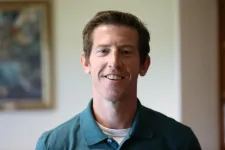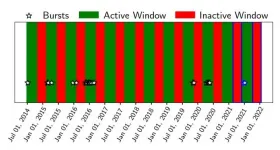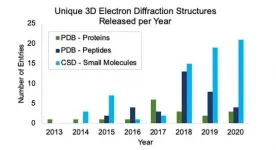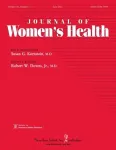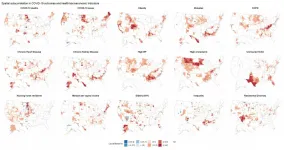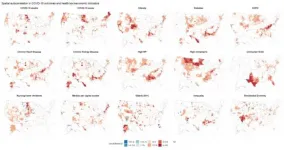(Press-News.org) WACO, Texas (July 13, 2021) - Climate change mitigation efforts have led to shifts from fossil-fuel dependence to large-scale renewable energy. However, renewable energy sources require significant land and could come at a cost to ecosystems. A new study led by Ryan McManamay, Ph.D., assistant professor of environmental science at Baylor University, evaluates potential conflicts between alternative energy strategies and biodiversity conservation.
The study, published in Biological Conservation, evaluates potential tradeoffs between climate benefits and energy costs, especially any negative impacts on biodiversity. While the environmental consequences of some renewable energy sources, like hydropower, have been widely studied, the large-scale impacts of other renewables, like solar, aren't well known.
"The study points to a need for the global community to understand the opposing endpoints of sustainability, which are scale-dependent," McManamay said. "At one endpoint, efforts to mitigate climate change at global scales via large-scale energy transitions may be completely incognizant of the consequences on local biodiversity. Likewise, local conservationists may not appreciate the magnitude of energy transitions required to shift global carbon emissions. Finally, I think there is a broad misconception among much of the community that if renewable energies are good for climate, they must also be good for the local ecosystem. Energies like solar have the potential to be deployed haphazardly with that mindset."
The challenges of climate mitigation in relation to different climate policy scenarios are projected in five Shared Socio-economic Pathways (SSPs) -- qualitative descriptions of plausible alternative socio-economic development in the next century. The SSPs include alternative projections in deployment of electricity generations by technology. Considering scenarios under the SSPs, ecological footprinting was used to evaluate the potential land and biodiversity tradeoffs of 10 different energy sources: solar photovoltaic, concentrated solar power, wind, hydropower, coal, conventional oil, conventional gas, unconventional oil, unconventional gas, and biomass.
"Ecological footprinting took into account land-use efficiencies of each technology as well as estimates of the degree of habitat alteration arising from technology deployment," McManamay said. "This provides a standardized way to compare the biodiversity consequences of large-scale deployment of alternative energy technologies."
Researchers estimated a biodiversity footprint for each of the 10 energy sources by overlaying energy densities and habitat alteration probabilities with biodiversity patterns. They then used spatial modeling to examine regional variations in future energy deployment and potential biodiversity impacts at a high-resolution. Different biodiversity footprints were scored based on their impact and a cumulative biodiversity score was determined for each of the 10 energy sources.
The cumulative impact scores among the SSPs showed significant and consistent differences -- the fossil-fueled development pathway (SSP 5) had the highest impacts while the regional rivalry scenario (SSP3) had the lowest. The sustainability-focused scenario (SSP1) represented a moderate impact score by comparison. Unexpectedly, the variation among SSPs didn't show a clear tradeoff between global climate mitigation and cumulative biodiversity impact.
"It was surprising to see the lack of a clear tradeoffs among sustainability endpoints," McManamay said. "This elicited us to take a deeper look into differences among the SSPs. Although SSP5 is termed 'fossil-fueled' development, the pathway includes significant technological advances in both advanced fossil and renewable technologies to meet highly consumptive, energy-luxurious lifestyles. In other words, the biodiversity impacts are more related to total energy deployment than fossil versus renewable technologies. Although SSP1 is also characterized by significant renewable energy deployment, overall energy demand decreases due to increases in energy efficiencies. So, our work suggests that climate mitigation may not necessarily have to be at odds with biodiversity conservation."
Additionally, land constraints accounted for the most variation in biodiversity impact, particularly with regard to protected land use. Downscaled electricity generation scenarios were constrained by alternative land conservation and energy development policies.
The results offer an approximation of land and biodiversity impacts of future energy strategies outlined in the SSPs. While there were differences in the SSPs, the impact scores suggest that land protection measures and energy diversification could have greater implications for biodiversity challenges than the national-level global energy pathways outlined in the SSPs. Future planning and objectives for climate mitigation will require both broad and local consideration of biodiversity challenges.
INFORMATION:
*Chris R. Vernon of the Pacific Northwest National Laboratory, and Henriette I. Jager of the Oak Ridge National Laboratory are co-authors of the study.
ABOUT BAYLOR UNIVERSITY
Baylor University is a private Christian University and a nationally ranked research institution. The University provides a vibrant campus community for more than 19,000 students by blending interdisciplinary research with an international reputation for educational excellence and a faculty commitment to teaching and scholarship. Chartered in 1845 by the Republic of Texas through the efforts of Baptist pioneers, Baylor is the oldest continually operating University in Texas. Located in Waco, Baylor welcomes students from all 50 states and more than 90 countries to study a broad range of degrees among its 12 nationally recognized academic divisions.
Cancer survivors ages 18 to 64 faced fewer financial barriers to health care after the Affordable Care Act was implemented than they did before the landmark law took effect, University of Michigan researchers found.
In fact, they believe the ACA helped the financial burden (problems related to the cost of medical care) for younger cancer survivors fall to its lowest estimated levels in 20 years.
"There has been a lot of talk about the ACA affecting people who don't have the Medicare safety net," said Christopher Su, M.D., a clinical fellow in the division of hematology and oncology at Michigan Medicine and the first author of the paper. "We were able to drill down to that and show that it did make a difference to younger cancer ...
The COVID-19 pandemic and the situations of stress and sadness associated with it have not significantly increased the prevalence of depression and anxiety among participants in the Brazilian Longitudinal Study of Adult Health (ELSA-Brazil) who live in the city of São Paulo.
ELSA-Brazil has been monitoring the overall health of 15,000 civil servants at six public universities and research centers in Brazil since 2008. The survey on mental health during the pandemic was conducted in São Paulo and involved 2,117 members of the staff of the University of São Paulo (USP) - in active service or retired - who are participants in the nationwide study and aged 50-80.
The survey is supported by São Paulo Research Foundation ...
In early March 2020, the University of Washington became the first four-year U.S. university to transition to online-only classes due to the COVID-19 pandemic.
Many researchers predicted severe consequences of these physical distancing measures. To understand how this change affected college students' mental health, UW researchers surveyed 147 UW students over the 2020 spring quarter, which began shortly after the university transitioned to online-only classes. The team compared the students' responses to a previous survey of 253 students in spring quarter 2019.
The researchers didn't see much change in average levels of students' depressive symptoms, anxiety, stress or loneliness between 2019 and 2020 or between the beginning and the end of spring quarter ...
Magnetars are bizarre objects -- massive, spinning neutron stars with magnetic fields among the most powerful known, capable of shooting off brief bursts of radio waves so bright they're visible across the universe.
A team of astrophysicists has now found another peculiarity of magnetars: They can emit bursts of low energy gamma rays in a pattern never before seen in any other astronomical object.
It's unclear why this should be, but magnetars themselves are poorly understood, with dozens of theories about how they produce radio and gamma ray bursts. The recognition of this unusual pattern of gamma ray activity ...
Bacterial vaginosis is the most common and recurrent gynecological condition affecting nearly 30% of women between the ages of 15 and 44, according to the U.S. Centers for Disease Control and Prevention. A University of Arizona Health Sciences-led study recently identified a specific bacteria family and uncovered how it contributes to bacterial vaginosis, paving the way for new insights into disease prevention and treatment.
Led by Melissa Herbst-Kralovetz, PhD, a member of the BIO5 Institute and associate professor of basic medical sciences at the College of Medicine - Phoenix, researchers found that members of the Veillonellaceae bacteria family contribute to an increase in inflammation and cell death, and alter the acidity of the cervical microenvironment. These changes support bacterial ...
CAMBRIDGE July 13, 2021 - To date, solving structures of potential therapeutics using X-ray diffraction (XRD) has been an assumed, pivotal step in the drug development process. But a recent paper by a team of researchers led by NanoImaging Services shows how microcrystal electron diffraction (MicroED) is growing to obtain the structures of potential pharmaceuticals.
Three-dimensional crystal structures that show the relative positions of atoms, bonds and intramolecular interactions are needed to understand stability, reactivity, solubility and, ultimately, suitability ...
New Rochelle, NY, July 13, 2021--Males with COVID-19 had significantly higher rates of hospitalization and of transfer to the intensive care unit (ICU) according to a new study. A higher percentage of males died of COVID-19 compared to females, as reported in the study published in the peer-reviewed Journal of Women's Health. Click here to read the article now.
Joanne Michelle Gomez, MD, Rush University Medical Center, and coauthors, studied the first 8,108 positive COVID-19 patients that presented to the Rush University System from March 1-June 21, 2020. Nineteen percent of males required hospitalization, compared to 13% of females. ...
In a new study of adults from the general population who were infected with COVID-19 in 2020, more than a quarter report not having fully recovered after six to eight months. Those findings are described this week in the open-access journal PLOS ONE by Milo Puhan and colleagues at the University of Zurich, Switzerland.
While initial public health responses to the SARS-CoV-2 virus focused on reducing the acute burden of COVID-19, a growing body of evidence indicates that the infection can also result in longer-term physical and mental health consequences. These long-term consequences, currently referred to as "post-COVID-19 syndrome" or "Long Covid" are ...
COVID-19 vaccination strategies in the United States are informed by individual characteristics such as age and occupation. A study published in the open access journal PLOS Medicine by Sasikiran Kandula and Jeffrey Shaman of Columbia University, New York, United States suggests that including socioeconomic indicators as prioritization criteria for vaccination may help minimize severe outcomes, particularly deaths.
Efforts to reduce COVID-19 mortality rates in the US have focused on prioritizing vaccination initially for those at a higher risk of severe outcomes. The effectiveness of population-level ...
An estimated 43 percent of the variability in U.S. COVID-19 mortality is linked with county-level socioeconomic indicators and health vulnerabilities, with the strongest association seen in the proportions of people living with chronic kidney disease and living in nursing homes. The study by Columbia University Mailman School of Public Health researchers suggests that allocating vaccines based on these factors could help minimize severe outcomes, particularly deaths. Results are published in the open-access journal PLOS Medicine.
"It is well known that COVID-19 deaths are concentrated in communities with underlying ...
